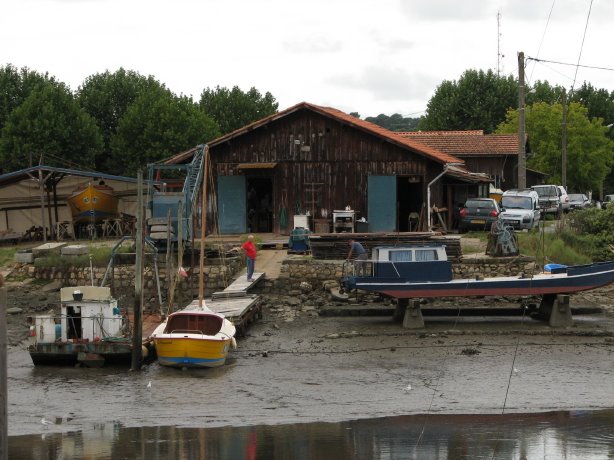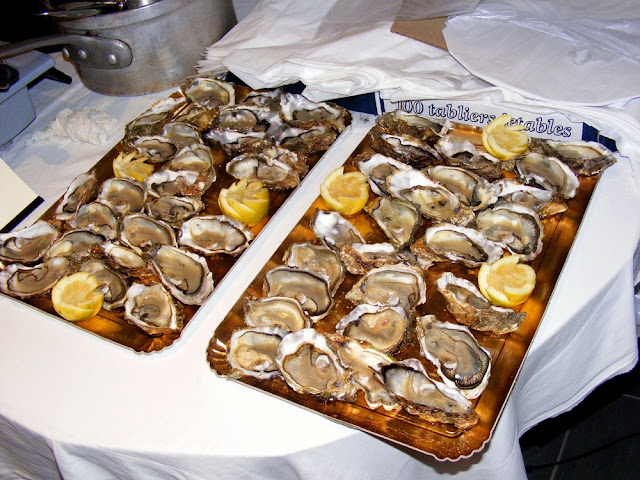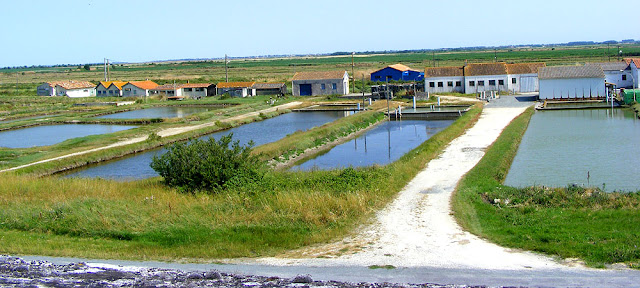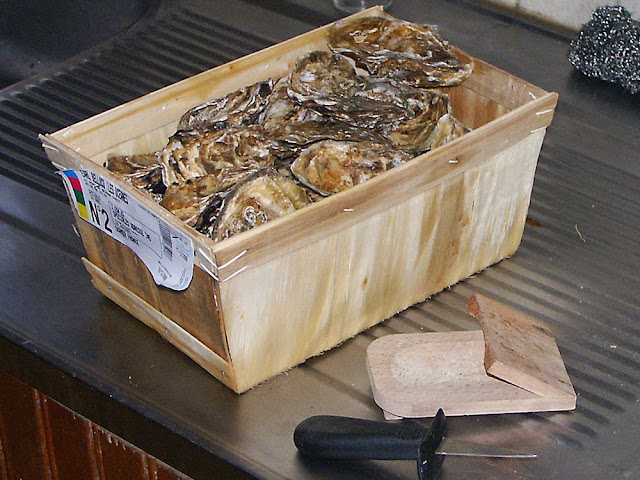 |
| An oyster producer in the Arcachon basin on the Atlantic coast. |
There are four main varieties of oysters to look out for:
 |
| Oysters au naturel prepared by Cédric the sous-chef at the Hotel Clos d'Amboise. |
La Plate ('the flat'): for centuries this was the only oyster to be had on the coast of France, but a disease caused their disappearance in the 1970s. Quite rare today, you find them sold as belon in Brittany and gravette in the Arcachon Bassin and Bouzigues. The wild variety is called pied-de-cheval ('horse hoof'). L'huître plate can be recognised by its round shell and grey-white flesh. It has a full-bodied flavour, very salty and should be prepared with the greatest simplicity.
 |
| An historic painted tile panel in Tours train station. Once upon a time you could catch a train from Tours to Arcachon. |
La Creuse ('the hollow'): This is by far the most common and the most affordable. They vary subtley in flavour depending on their geographical origin - salty and nutty from Normandy, iodiney and recalling the shallow estuaries in Brittany, delicate and invigorating from the Atlantic coast. Allow 6-8 oysters per person if you are eating them raw, and 5 if they are served warm. They are numbered from 0 (the biggest and fattest) to 6 (the smallest). On a platter, numbers 3-4 are ideal.
 |
| Oysters au naturel prepared by me for an al fresco lunch. |
La Pousse en Claire ('the saltmarsh grown'): A little gem from the Charentes, protected by a Label Rouge certification, this is the most desirable variety, unlike any other. Raised from 4 to 6 months in shallow water, only 2 to 5 oysters per square metre, they acquire an almost crunchy firmness. Generously filling out their semi round shell they have a mild sweet taste. If you find them, eat them as they are, as they need nothing to enhance them.
 |
| The flotilla of oyster boats heads out to the oyster beds from Bourcefranc, in the Marenne Oléron marine park. |
La Fine ('the fine'): A speciality of Marennes and Oléron, these oysters are finished in the old salt marshes. The fines stay there a month, 20 oysters to a square metre. An even more deluxe version, the spéciales, are only 10 to the square metre and stay in the saltmarsh twice as long, developing more flesh with a very sweet flavour. The vertes (green fringes) are very prized, retaining traces of a microscopic algae. They are eaten plain or with a drop of lemon juice, a trace of shallot vinegar and bread and butter.
 |
| A big fat oyster from the market at Ars-en-Ré, probably the best I have ever eaten. |
 |
| Oyster producers' huts on the Ile d'Oléron. |
 |
| Claires, or oyster finishing ponds in the Brouage saltmarsh. |
 |
| Me opening No 2 Speciales (large saltmarsh finished oysters) in our freezing cold kitchen before we renovated. |
 |
| A 3 kg (3 dozen) box of No 2 speciales, with opener. |
 |
| No
2 Oysters from the islands off the coast of the Atlantic coast, brought
2 hours inland to Preuilly sur Claise in the Touraine Loire Valley for the Saturday
market. €5.40 a dozen. |
 |
| Oyster beds on the Ile de Ré. |
************************************************
For details of our private guided tours of chateaux, gardens, wineries, markets and more please visit the
Loire Valley Time Travel website. We would be delighted to design a tour for you.
We are also on
Instagram, so check us out to see a regularly updated selection of our very best photos. You may also like to check out our
YouTube channel.













4 comments:
It must be a sight and texture thing but, so far, I have been unable to eat a raw oyster.
Marennes and Oléron are all oysters for miles!!! Have eaten them with the French family years ago but not keen...C
As usual, very interesting and informative post.
I don’t know of anything I like best than oysters, and Belons are at the top. I think I could eat several dozens of raw oysters without being fed up but wanting more!
I hope the Belon or pleine mer makes a come back.
I do love them so! I've been known to eat two dozen, but usually 12 will do. Being in provence, the common oyster here is (I believe) a "creuse" from Bouzigues. I usually buy No. 2 as they are big enough and not too hard to open. I bought No. 0 once and had a real battle opening them -- but did find a pearl in one of them. I have had oysers from the atlantic, and like the "fine de claires" very much, but sadly have never had a "plate". Maybe next year at christmas I will hunt some down.
bonnie in provence
Post a Comment